What You Need to Know About Muscle Soreness
Muscle soreness is the pain and stiffness you feel after physical exertion. It's a nearly universal experience, whether you're an athlete, a weekend warrior, or someone with a physically demanding job. Here’s a quick overview:
Quick Facts:
- What it is: Pain from microscopic tears in muscle fibers.
- When it starts: 12-24 hours after exercise (known as DOMS.pdf?sfvrsn=8f430e182.pdf?sfvrsn=8f430e182)).
- Peak pain: Typically 24-72 hours after activity.
- How long it lasts: Usually 3-5 days.
- Common causes: New exercises, increased intensity, or eccentric movements (like running downhill).
- Relief options: Rest, gentle movement, heat, massage, topical creams, and hydration.
While uncomfortable, muscle soreness is often a sign that your muscles are adapting and growing stronger. The good news is that it's usually temporary and can be managed at home. At Neuropasil, we're dedicated to helping you find relief from muscle soreness and nerve pain with effective, natural solutions. Understanding how to treat soreness can help you recover faster and stay active.
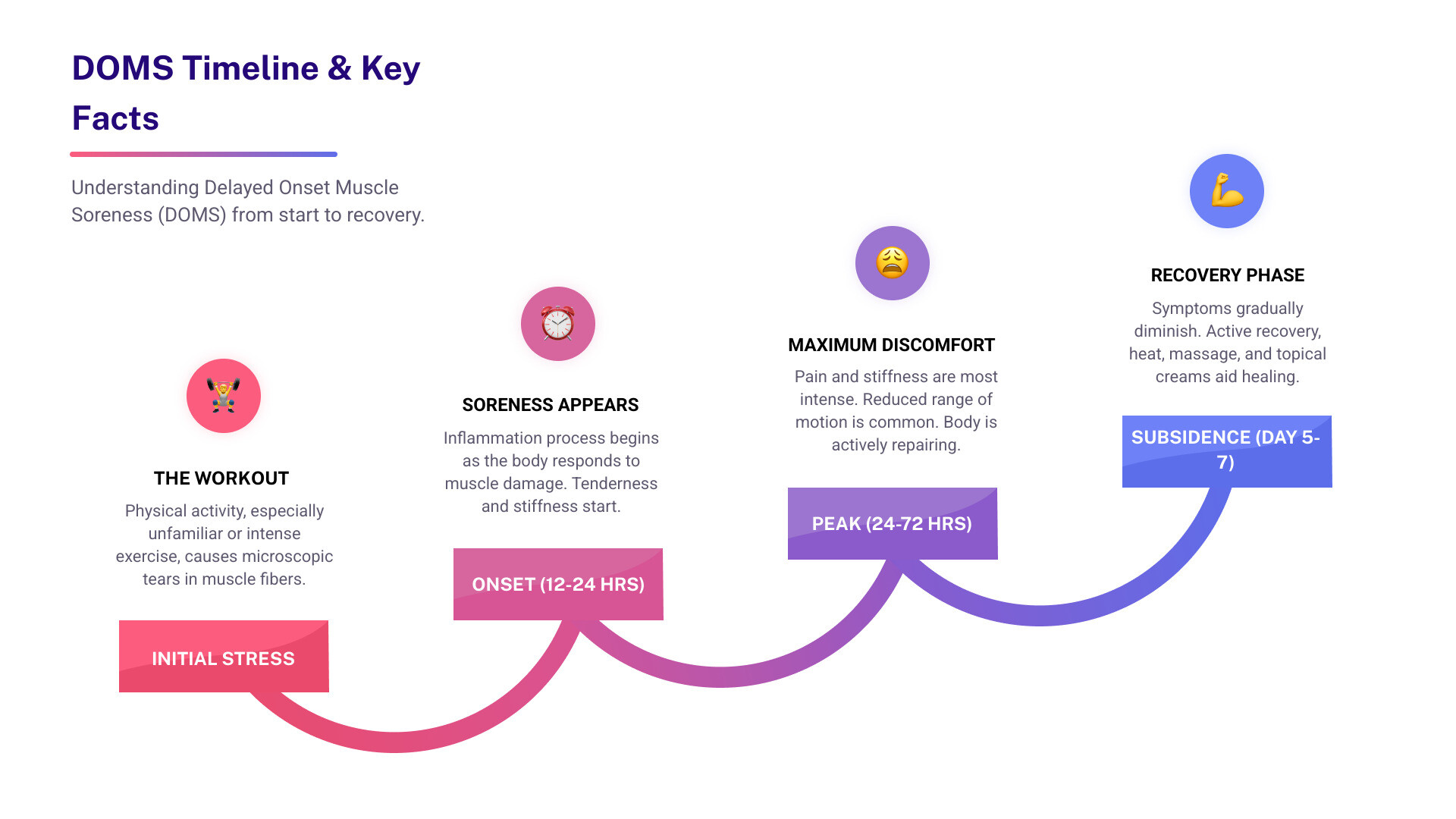
Understanding the Ache: What is Muscle Soreness?
That familiar tenderness or dull ache that settles into your muscles after a tough workout is muscle soreness. Medically known as myalgia, it's your body's signal that it's adapting and getting stronger.
The usual culprits are tension, overuse, and minor injuries from exercise. When you challenge your muscles with a new or intense activity, you create microscopic damage in the muscle fibers. This sounds alarming, but it's a necessary step for muscle growth. Your body responds with a repair process involving inflammation, which ultimately builds more resilient tissue.
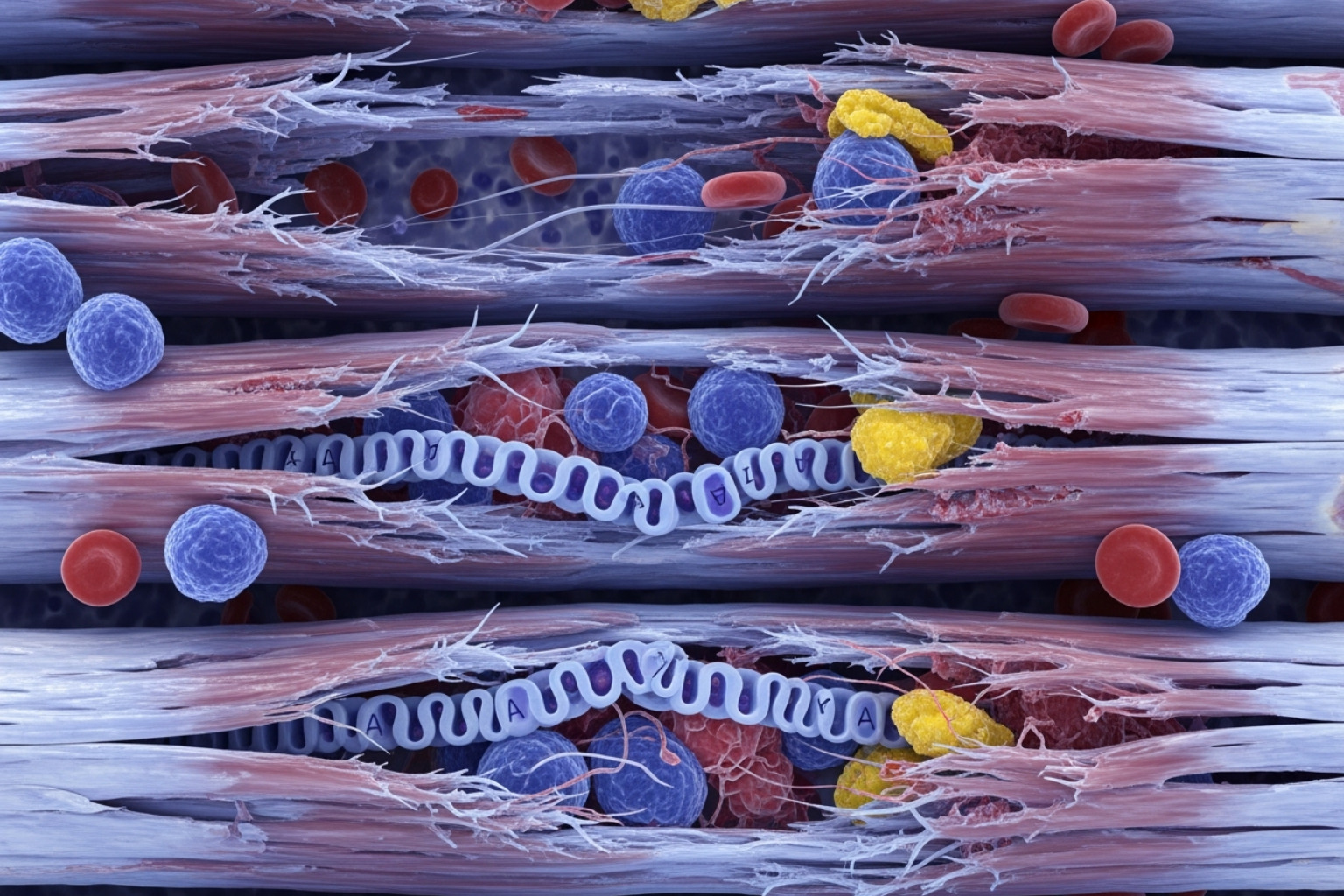
The Science Behind the Ache: Eccentric Contractions and Inflammation
Much of post-exercise soreness comes from eccentric muscle contractions—when muscles lengthen under tension. Think of slowly lowering a weight, controlling your descent in a squat, or running downhill. These movements are particularly effective at causing micro-tears in muscle fibers.
These tiny tears trigger an inflammatory response. Your body's internal repair crew rushes to the site to clear out debris and begin healing. This inflammation is crucial for repair, but it's also a primary reason you feel pain and tenderness, especially with delayed onset muscle soreness. For a deeper dive, scientific research on DOMS mechanisms explores this process at a cellular level.
Acute Soreness vs. Delayed Onset Muscle Soreness (DOMS)
There are two distinct types of muscle soreness.
Acute muscle soreness is the immediate burning you feel during a workout. It's caused by a buildup of metabolic byproducts and muscle fatigue. This type of soreness is short-lived, fading soon after you stop exercising.
Delayed Onset Muscle Soreness (DOMS) is the ache that appears 12 to 24 hours later. The pain typically peaks between 24 and 72 hours post-exercise and subsides over 3 to 5 days. DOMS is the result of the microscopic muscle tears and inflammation discussed earlier.
| Feature | Acute Muscle Soreness (AMS) | Delayed Onset Muscle Soreness (DOMS).pdf?sfvrsn=8f430e182.pdf?sfvrsn=8f430e182) |
|---|---|---|
| Onset | During or immediately after exercise | 12-24 hours post-exercise |
| Duration | Minutes to a few hours | 3-5 days (peak 24-72 hours) |
| Primary Cause | Metabolic byproduct buildup, fatigue | Microscopic muscle damage, inflammation |
| Sensation | Burning, aching, fatigue | Dull ache, tenderness, stiffness |
Common Symptoms of Muscle Soreness
When muscle soreness sets in, you'll likely notice several common symptoms:
- Tenderness to touch: Muscles feel sensitive or painful when pressed.
- Reduced range of motion: Difficulty fully extending or flexing a limb.
- Mild swelling: Some puffiness in the affected muscle area.
- Muscle fatigue: Muscles feel weaker or tire more easily.
- Stiffness: A tight, restricted feeling, especially after being still.
- Pain with movement: The ache intensifies when you use the sore muscles.
These symptoms are a normal part of the healing process that makes you stronger.
Effective Relief: Managing and Preventing Muscle Soreness
While muscle soreness can be a sign of progress, you don't have to just endure it. There are many effective ways to ease the discomfort, speed up recovery, and minimize future soreness. The key is to work with your body's natural healing process.
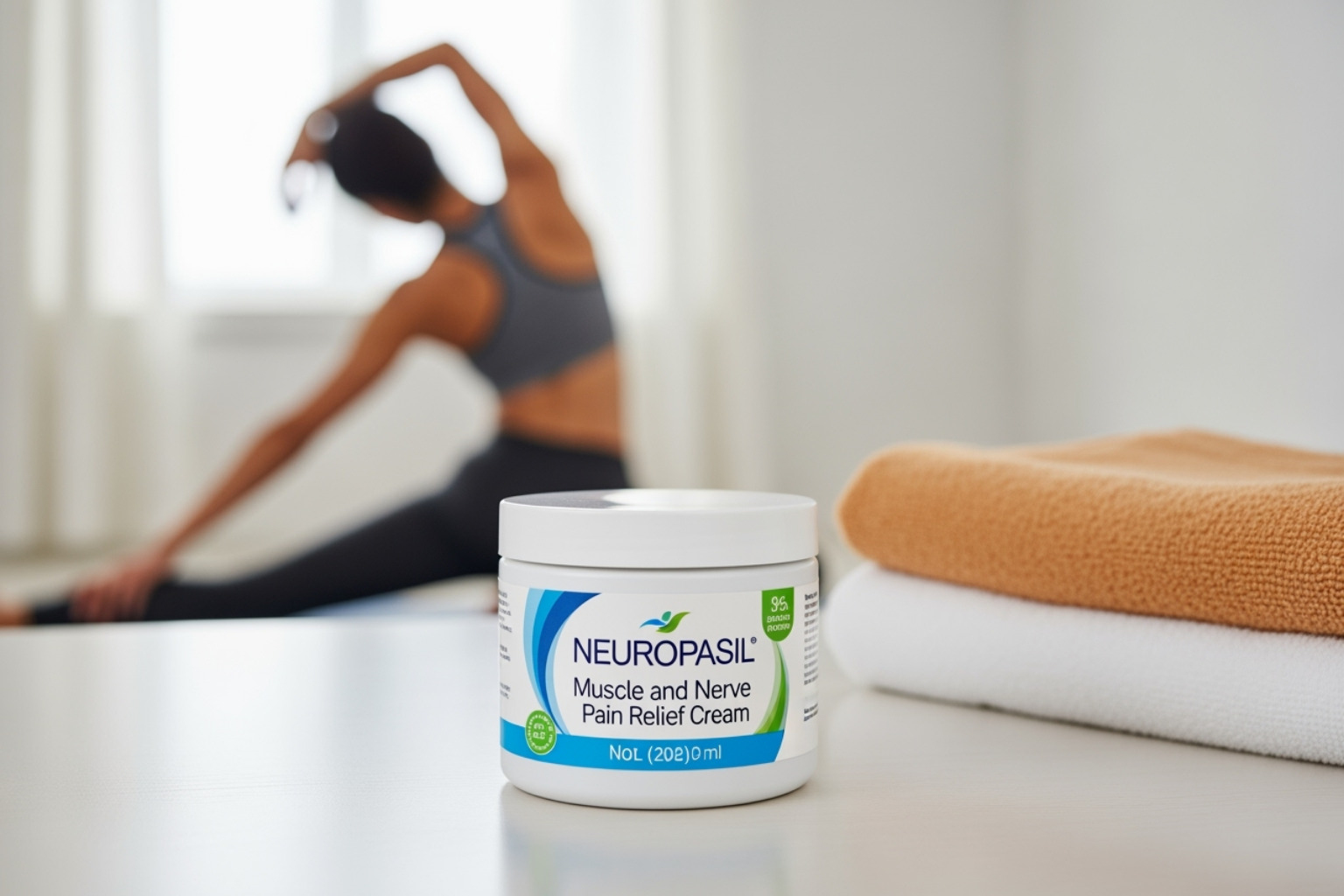
Home Strategies for Mild Muscle Soreness
For mild soreness, simple home strategies can make a big difference.
- Active Recovery: Instead of complete rest, try gentle movement. A leisurely walk, light cycling, or gentle yoga increases blood flow to sore muscles, delivering oxygen and nutrients while clearing waste. This can reduce stiffness and improve comfort.
- Massage: Self-massage or using a foam roller can relieve tension and boost circulation. For extra relief, combine massage with a topical cream to soothe the area as you work out knots.
- Heat Therapy: A hot bath or heating pad is excellent for general stiffness. Warmth relaxes tight muscles and encourages blood flow, and research shows it can ease DOMS pain.
- Cold Therapy: Ice packs or cold baths can help with acute, throbbing pain by reducing inflammation and numbing the area. However, some evidence suggests applying cold immediately after resistance training might slow muscle growth, so use it primarily for pain relief in the first day or two.
- Rest and Elevation: Don't underestimate proper downtime. Your body repairs itself during rest. Elevating a sore limb can also help reduce swelling.
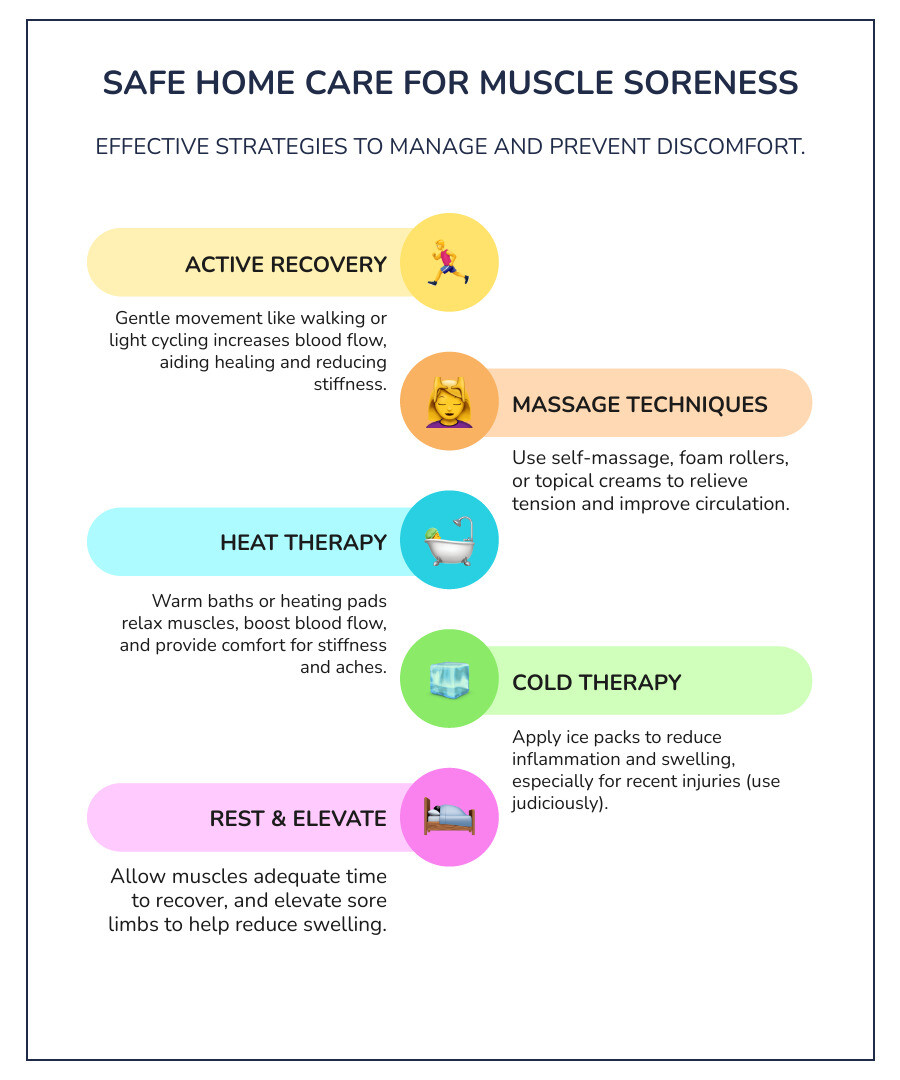
Targeted Topical Solutions for Muscle and Nerve Pain Relief
For relief that goes straight to the source, a muscle pain relief cream is an excellent choice. Unlike oral medications, topical creams deliver active ingredients directly to the sore tissue for faster action with fewer systemic side effects.
Our Neuropasil Muscle and Nerve Pain Relief Cream was developed to provide fast-acting, soothing comfort. The formula combines powerful natural ingredients:
- Aloe: Known for its anti-inflammatory and soothing properties.
- Urea: Helps other ingredients absorb more effectively.
- Menthol: Creates an immediate cooling sensation that interrupts pain signals, providing quick relief. Research supports menthol-based topicals for easing DOMS pain.
Simply apply a thin layer to your sore muscles and gently massage it in. It's a targeted solution for athletes with post-workout soreness and people managing daily aches from conditions like neuropathy, sciatica, fibromyalgia, strains, sprains, and joint discomfort.
How to Prevent Future Soreness
You can reduce the frequency and intensity of muscle soreness with smart prevention strategies.
- Proper Warm-Up: Dedicate 5-10 minutes to dynamic stretching before every workout. Movements like leg swings and arm circles increase blood flow and prepare your muscles for activity, which can decrease soreness.
- Gradual Progression: This is the most important strategy. Increase your workout duration or intensity, but not both at once. This principle of progressive overload allows your muscles to adapt without excessive damage.
- Cool-Down: After your workout, take 5-10 minutes for static stretching, holding each stretch for 20-30 seconds. This improves flexibility and supports long-term mobility.
- Hydration and Nutrition: Stay hydrated, as it helps muscle function and recovery. Fuel your body with adequate protein to rebuild tissue and carbohydrates to replenish energy stores.
- Sleep: Your body releases growth hormone and ramps up protein synthesis during sleep, both of which are essential for muscle repair. Prioritize quality rest for better recovery.

When Muscle Pain Is More Than Just Soreness
Most muscle soreness is a normal part of your body adapting and getting stronger. However, it's important to recognize when an ache might signal something more serious. Chronic muscle pain that doesn't improve with rest or appears without a clear cause may point to an underlying issue.
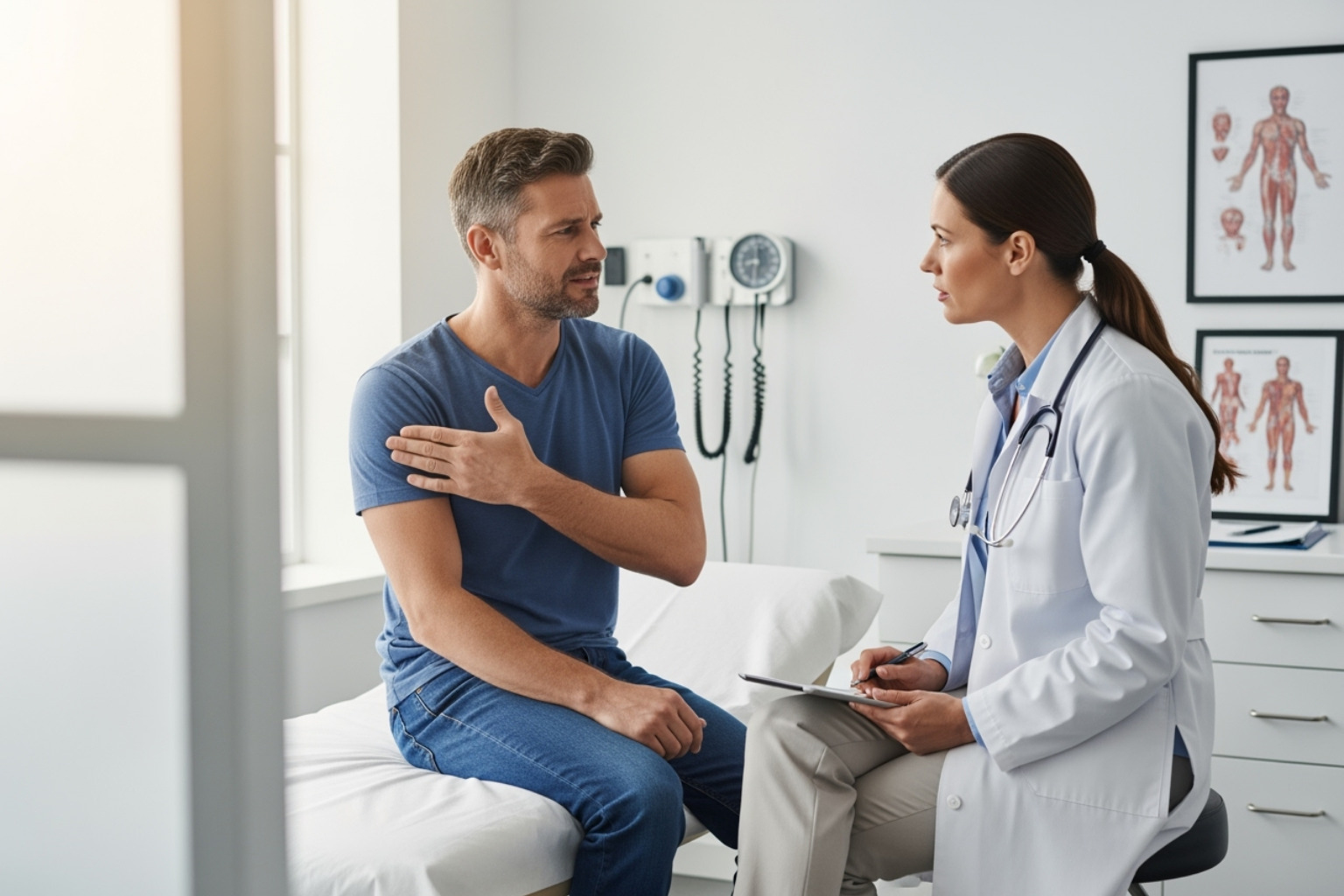
Underlying Medical Conditions That Can Cause Muscle Pain
If you have muscle pain without a recent workout to explain it, your body might be signaling another issue. Some potential causes include:
- Infections: The flu and other infections can cause body-wide aches as your immune system fights them off.
- Fibromyalgia: A chronic condition causing widespread pain, tenderness, and fatigue.
- Chronic Fatigue Syndrome (ME/CFS): A complex disorder that brings extreme exhaustion and muscle pain.
- Autoimmune Disorders: Conditions like Lupus or Polymyalgia Rheumatica can cause the immune system to attack muscle tissue, leading to pain and weakness.
- Medication Side Effects: Statins, used to manage cholesterol, are known to cause muscle pain (statin-induced myopathy) in some people.
- Hypothyroidism: An underactive thyroid can slow down body processes, resulting in muscle pain and weakness.
- Vitamin and Mineral Imbalances: Deficiencies in nutrients like vitamin D or imbalances in electrolytes like potassium can disrupt muscle function.
- Severe Muscle Strain: A significant tear in muscle fibers can cause intense pain.
- Chronic Exertional Compartment Syndrome: A rare condition where pressure builds in muscle compartments during exercise, causing pain.
The Mayo Clinic's guide to muscle pain causes is an excellent resource for more information.
Red Flags: When to See a Doctor
While most muscle soreness resolves on its own, certain symptoms warrant a call to your doctor. Seek professional medical advice if you experience any of the following:
- Pain that lasts longer than a week without improving.
- Severe pain from a minor injury or activity.
- Signs of infection at the painful site, such as redness, swelling, warmth, or discharge.
- Dark-colored urine, which can be a sign of rhabdomyolysis, a serious condition requiring immediate medical attention.
- Inability to move a limb or a complete loss of movement in a part of your body.
- Severe pain accompanied by tightness and tingling, which could signal compartment syndrome, a medical emergency.
- Muscle pain combined with fever, dizziness, or chest pain, which could indicate a life-threatening condition.
Rhabdomyolysis and compartment syndrome are rare but dangerous conditions. Rhabdomyolysis involves the rapid breakdown of muscle tissue, while compartment syndrome involves pressure cutting off blood supply. Both are medical emergencies. Trust your instincts—if something feels seriously wrong, get it checked out.
Frequently Asked Questions about Muscle Soreness
Here are answers to some of the most common questions we hear about muscle soreness.
Is it okay to work out with sore muscles?
It depends on the severity. For mild to moderate muscle soreness, light exercise—known as "active recovery"—can actually help. A gentle walk or easy bike ride increases blood flow, which can ease stiffness.
However, if your soreness is severe, limits your range of motion, or causes sharp pain, you should rest that muscle group. Pushing through intense pain increases your risk of injury. You can always work on a different, non-sore body part. The key is to listen to your body.
How long does muscle soreness typically last?
Delayed Onset Muscle Soreness (DOMS).pdf?sfvrsn=8f430e182.pdf?sfvrsn=8f430e182) follows a predictable timeline. It usually begins 12 to 24 hours after a workout, peaks between 24 and 72 hours, and then resolves within 3 to 5 days. Some soreness might linger for up to a week, especially after a particularly intense or new activity.
If your muscle soreness lasts longer than a week or is accompanied by red flag symptoms (like severe pain or dark urine), it's time to see a doctor.
Does stretching before a workout prevent soreness?
This is a common fitness myth. Static stretching (holding a stretch) before a workout does not prevent muscle soreness and may even temporarily decrease muscle power.
Instead, focus on a dynamic warm-up. Active movements like leg swings and arm circles increase blood flow and prepare your muscles for the work ahead. This can help reduce injury risk and may lessen the severity of soreness.
Save static stretching for your cool-down after the workout. While it won't prevent DOMS, it improves flexibility and long-term joint health.
Conclusion
Muscle soreness is a common, often positive sign that your body is adapting and growing stronger. Understanding the process behind the ache—from microscopic tears to the inflammatory response—empowers you to manage it effectively.
We've covered practical strategies for relief, such as active recovery, heat therapy, and smart prevention through proper warm-ups and gradual progression. Most importantly, we've highlighted the red flags that tell you when to seek professional medical help. Listening to your body is the wisest approach to both fitness and health.
When you need targeted, fast-acting relief, Neuropasil Muscle and Nerve Pain Relief Cream offers a natural, trusted solution. Our blend of Aloe, Urea, and Menthol delivers soothing comfort directly where you need it, helping you recover faster from post-workout soreness or daily muscle discomfort.
Learn more about our Muscle and Nerve Pain Relief Cream
References
Understanding muscle soreness and how to effectively manage it requires drawing on solid scientific research and trusted medical sources. Throughout this article, we've referenced numerous studies, clinical guidelines, and expert resources to ensure you're getting accurate, evidence-based information.
The mechanisms behind Delayed Onset Muscle Soreness (DOMS) have been extensively studied over the past several decades. Cheung, K., Hume, P., & Maxwell, L. (2003) provided a comprehensive review of treatment strategies and performance factors in their work published in Sports Medicine (https://pubmed.ncbi.nlm.nih.gov/12617692/). Earlier foundational research by Armstrong, R. B. (1984) in Medicine & Science in Sports & Exercise helped establish our understanding of exercise-induced muscle soreness mechanisms (https://doi.org/10.1249/00005768-198412000-00002).
For practical guidance on managing muscle soreness, we've consulted resources from leading health organizations. The American College of Sports Medicine (2022) offers an excellent info sheet on DOMS (https://www.acsm.org/docs/default-source/files-for-resource-library/delayed-onset-muscle-soreness-(doms).pdf?sfvrsn=8f430e182.pdf?sfvrsn=8f430e182), while the Cleveland Clinic provides accessible information on myalgia and muscle strains (https://my.clevelandclinic.org/health/symptoms/myalgia-muscle-pain and https://my.clevelandclinic.org/health/diseases/22336-muscle-strains).
The effectiveness of various treatment approaches has been rigorously examined. Petrofsky, J., et al. (2017) demonstrated the efficacy of sustained heat treatment on delayed-onset muscle soreness (https://pubmed.ncbi.nlm.nih.gov/27454218/), while Guo, J., et al. (2017) conducted a systematic review showing how massage alleviates DOMS (https://www.frontiersin.org/articles/10.3389/fphys.2017.00747/full). Research on cold water immersion by Xiao, F., et al. (2023) provided insights into fatigue recovery and exercise performance (https://pmc.ncbi.nlm.nih.gov/articles/PMC9896520/).
Interestingly, Herbert, R. D., et al. (2011) published findings in The Cochrane Database of Systematic Reviews showing that stretching before exercise doesn't effectively prevent muscle soreness (https://pubmed.ncbi.nlm.nih.gov/21735398/). This challenges common assumptions and helps us focus on more effective prevention strategies.
The importance of hydration was highlighted in a 2005 study by Cleary, M. A., et al., which found that proper hydration significantly reduced symptoms of delayed-onset muscle soreness in males exercising in hot conditions (https://pmc.ncbi.nlm.nih.gov/articles/PMC1323290/). Nutritional approaches were comprehensively reviewed by Tanabe, Y., et al. (2021) in their work on dietary supplementation for attenuating exercise-induced muscle damage (https://pmc.ncbi.nlm.nih.gov/articles/PMC8746365/).
For information on more serious conditions, we've referenced the Mayo Clinic's guide to muscle pain causes (https://www.mayoclinic.org/symptoms/muscle-pain/basics/causes/sym-20050866). Research on rhabdomyolysis by Shroff, K., et al. (2021) helped inform our section on red flag symptoms (https://pmc.ncbi.nlm.nih.gov/articles/PMC9728312/), while Torlincasi, A. M., et al. (2023) provided crucial information on acute compartment syndrome (https://www.ncbi.nlm.nih.gov/books/NBK448124/).
Additional valuable insights came from Mizumura, K., & Taguchi, T. (2016) on the involvement of neurotrophic factors in DOMS (https://pubmed.ncbi.nlm.nih.gov/26467448/), Nosaka, K., Newton, M., & Sacco, P. (2002) on the relationship between eccentric exercise-induced damage and soreness (https://onlinelibrary.wiley.com/doi/abs/10.1034/j.1600-0838.2002.10178.x), and Stauber, W. T. (1989) on eccentric muscle action and adaptation (https://doi.org/10.1249/00003677-198900170-00008).
We've also drawn on practical resources from organizations like NHS Inform (https://www.nhsinform.scot/healthy-living/keeping-active/before-and-after-exercise/pain-and-injuries-after-exercise), Healthline (https://www.healthline.com/health/doms), and Physiopedia (https://www.physio-pedia.com/DelayedOnsetMuscle_Soreness) to ensure our advice is both scientifically sound and practically applicable.
Research on specific interventions includes work by Nahon, R. L., et al. (2021) on physical therapy interventions for DOMS (https://www.sciencedirect.com/science/article/abs/pii/S1466853X21001206), Davis, H. L., et al. (2020) on sports massage effects (https://pmc.ncbi.nlm.nih.gov/articles/PMC7228568), and Reno, A. M., et al. (2022) on magnesium supplementation (https://journals.lww.com/nsca-jscr/abstract/2022/08000/effectsofmagnesiumsupplementationon_muscle.19.aspx).
The role of sleep in muscle repair is detailed by Dattilo, M., et al. (2011) in Medical Hypotheses (https://pubmed.ncbi.nlm.nih.gov/21550729/). The efficacy of topical menthol was compared to ice by Johar, P., et al. (2012) in the International Journal of Sports Physical Therapy (https://www.ncbi.nlm.nih.gov/pmc/articles/PMC3362986/).
All of these sources have informed our understanding and helped us provide you with reliable, actionable information about managing muscle soreness effectively and safely.














